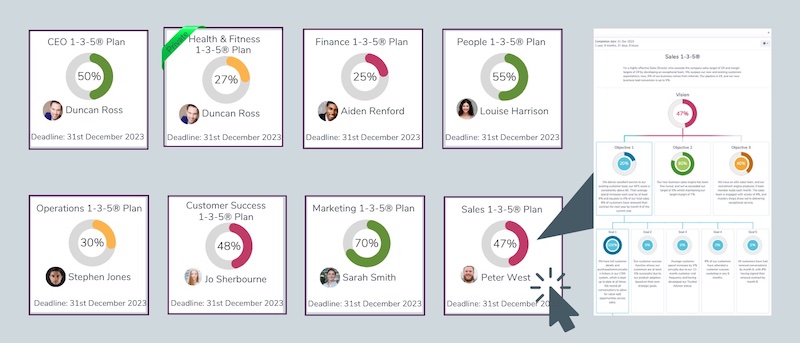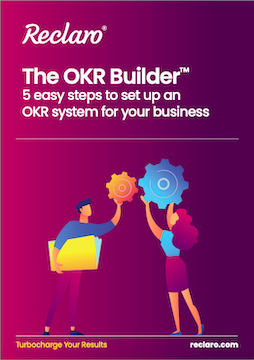
Last updated 16 December 2022 ·

Understanding, choosing and using the best OKR software for you and your business.
Great organisations are built atop extraordinary aspirations. Google aspires “to organise the world’s information and make it universally accessible and useful.” LinkedIn strives “to connect the world’s professionals to make them more productive and successful.” And Netflix has set its sights on “being the best global entertainment distribution service.”
These companies began like any other, a handful of people coming together around a new idea. How did they fend off copycats and outpace the competition to become multinational juggernauts? With a structured, repeatable framework for creating and cascading company goals to hundreds of employees.
If you want to take a page out of the books from Google, .Netflix, or LinkedIn, you need to understand a few essential things:
Contents
- The origins of the OKR framework
- How enterprise-level OKRs work today
- Using OKR software to achieve your organisation's vision
- Tips for OKRs that play nicely with tracking software
- Six signs your organisation needs OKR software
- Qualities all the best OKR software have in common
- The essential features and specific capabilities in enterprise OKR software
- How to clarify and specify what you need from OKR software
- Ten questions to ask yourself and vendors when vetting OKR software
- Pulling it all together: Organising, prioritising and choosing the right OKR software for you and your business
The origins of the OKR framework
In 1954, legendary management consultant Peter Drucker developed his Management By Objectives (MBO) approach to enterprise alignment. It pulled management out of day-to-day production to refocus on long-term high-level strategies for growth and profitability.
In Drucker’s own words, “A manager sets objectives, organises, motivates and communicates, sets yardsticks, and measures people.”
In addition to getting managers to focus on high-level strategies for execution, MBO also introduced objectives. Everyone from managers to rank-and-file employees was given objectives. Each person had to achieve their objective by a specific date to help the organisation achieve a larger objective. While this may sound strikingly similar to today’s OKR methodology, there were serious flaws.
The way Drucker saw it, “Management By Objective works – if you know the objectives. Ninety per cent of the time, you don’t.”
Another way to describe the problem is that objectives are destinations without a predetermined route. And so MBO delivered middling results…until Intel CEO Andrew Grove added a compass to the MBO approach.
In his book High Output Management, Grove pointed out that giving managers and employees objectives wasn’t enough. He wanted everyone with an objective to have a crystal clear answer to the question, “How will I pace myself to see if I’m getting there?”
He called these pace markers “key results.” And thus, the modern Objectives and Key Results (OKR) framework was born.
How enterprise-level OKRs work today
Since Grove’s original take, the big-picture view of organisational OKR implementation has mostly stayed the same. First, executives decide on an ambitious vision. They might base it on an existing mission or vision statement or derive it from a new focus. Once they’ve settled on their vision, they decide how to achieve it.
Objectives
Executives and managers must clarify and define concrete objectives that their teams can achieve. Remember, objectives are akin to “destinations” and can cover various topics. Here are some examples:
- A nonprofit may want to increase donation revenue by 10% over the next 12 months.
- A service-oriented business may want to increase employee satisfaction scores during the holiday season.
- An education provider may want to make all their courses available for distance learning before the next term begins.
There should be little wiggle room in how managers and employees interpret objectives, and no one should be given an objective that they cannot improve through their own efforts.
Key Results
When everyone understands their “north star,” they can begin planning the most effective route to get there. Key results are specific, time-bound metrics that track progress toward an associated objective. One objective can be comprised of several key results. However, sticking to between four and five per objective tends to be the most effective approach.
Key results should have a starting value (not necessarily zero) and a target value. They may look something like these:
- A nonprofit may focus on increasing donor retention rate year-on-year by 5%.
- A service-oriented business may work towards collecting a certain number of suggestions for improvement from employees.
- An education provider may record three live lectures per week for distance learning courses.
Your key results must be black and white, measurable and verifiable. As each key result inches toward 100%, your objectives will begin to feel within reach.
For more OKR examples, visit our comprehensive guide - OKR examples to visualise this goal-setting framework in action.
Cascading OKRs
In most enterprise-level organisations, there will be multiple tiers or “layers” of the OKR framework. At the top, C-suite executives will define broad objectives that apply to the whole organisation. Then, executives will work with department managers that report to them on defining key results. Those department managers will create their objectives and key results to cascade to their subordinates.
Every team and individual should have OKRs that contribute in some form to the vision of the whole company. It’s simple in theory but can become complicated in practice. And that’s where an OKR tracking tool can help.
Using OKR software to achieve your organisation’s vision
For small, low-growth companies (less than 100 employees), cascading objectives and key results from management down to individuals usually doesn’t require more than a couple of meetings, emails, and spreadsheets. In those cases, that’s enough to track OKRs across departments and teams. For companies that are expanding quickly and organisations with more than 100 employees, keeping everyone aligned is unrealistic without OKR tracking tools.
Manually tracking and updating OKRs in spreadsheets or documents is problematic for several reasons:
- It’s incredibly tedious and time-consuming - You need to track down individuals who can provide up-to-date information for key results, not to mention entering the data.
- It’s error-prone - Someone could mess up an equation in a spreadsheet cell or update one key result based on outdated data from another (dependent) key result.
- Reports are limited and uninspiring - OKRs are supposed to motivate employees. But few people would describe anything contained in a spreadsheet as inspirational.
OKR software pays for itself many times over by optimising the setting, tracking, and sharing objectives and key results. It automates significant portions of the process, so employees and managers have more time to work on what matters. Tracking tools enable everyone to see how their progress contributes to the company’s overall vision in real time.
OKR software is also invaluable for performance management and performance improvement. Employees and managers are always one click away from up-to-date information about progress on agreed-upon goals and upcoming deadlines. This leaves no room for misunderstandings or miscommunications about an individual’s or team’s contributions.
Despite all the benefits, determining precisely when your organisation should begin investing in OKR software often takes more work. There are, however, several red flags that something needs to change.
Simplify OKR management with tracking tools
Ultimately, OKR management software shouldn’t force you to change the types of objectives and key results you want to focus on. Although many of the same best practices apply, it’s worth reframing your goal setting within the context of digital tools.
You’ll focus on OKRs that keep staff motivated and inspired for extended periods. Otherwise, when employees feel like they see a new objective every time they open their dashboard, they start to feel left out of the process, like they need more time to contribute to the vision before the organisation moves on without them.
Another critical thing to keep in mind is tracking a mixture of OKRs that are audacious and easily attainable. Focus too much on the former, and teams will develop burnout or feelings of inadequacy (assuming they can’t consistently accomplish audacious objectives). Focus too much on the latter, and they’ll become complacent and lose motivation.
Companies of all sizes should also avoid setting pass/fail key results. Typical examples are “launch initiative X” or “finish feature Y.” These key results don’t provide significant insight into progress toward objectives. They are too prescriptive to inspire creativity and initiative among employees. If it reads like a to-do list item, it should be on someone’s to-do list, not among the company’s OKRs.
Lastly, keep the crawl-walk-run principle in mind. Consider rolling out software-tracked OKRs to a single team first, ideally a group of managers or department heads. Have them learn the ropes and work out the kinks before getting the entire organisation to adopt a tool-centric approach to tracking objectives.
OKR software enables you to significantly increase the number and variety of OKRs you track. Unfortunately, misconceptions and reservations about the value and effectiveness of these tools are common among enterprise executives. Even when there is clear and unarguable evidence to the contrary.

6 Signs your organisation needs OKR software
The earlier you can centralise and codify OKR management, the better results you’ll achieve. But if you’re struggling to get buy-in from leadership or need to make a case for allocating the budget to OKR management tools, here are some common signs that it’s time to make the switch:
- Progress on key results is updated haphazardly and inconsistently.
- Teams with related or interconnected objectives work in siloes without updating each other.
- Individuals or managers frequently change objectives or key results without informing relevant stakeholders.
- Employee performance reviews lack measurable and verifiable data or rely too heavily on “gut feelings.”
- Few people can recite your organisation’s overall vision or objectives from memory.
- There’s too much focus on the output quantity rather than the outcome quality.
Once there’s enough evidence that OKR software will deliver sufficient ROI, you have a new hurdle to get over: finding the tool that fits your organisation’s specific needs.
Qualities all the best OKR software have in common
Ever since Google’s viral presentation in 2013 on OKR tracking, the proliferation of software tools has been rapid and unrelenting. Some of these tools have niche use cases. Some of them leave a lot to be desired. Before looking at feature lists or pricing tiers, it’s essential to take a step back and consider what your organisation wants from OKR software. In all likelihood, you’ll be looking for some combination of the following:
User-friendly and easy to use
Regardless of the specific OKRs you need to track, the tools you use to measure and share progress need to be intuitive. Data will inevitably become unreliable and outdated if your managers and employees dread using your OKR software. This will frustrate others who need to use the tool, creating a negative feedback loop. Above all else, you need convenient, engaging software that doesn’t get in the way of work or slow anyone down. Many versions of OKR software available have become somewhat over complicated as they have developed an all-bells-and-whistles approach. Keeping things simple is often more difficult, but that’s where the advantage of having a light-touch system comes as it’s sure not to get in the way of work but simply directs the course of action each day.
Consistent and consolidated reporting
It should never take more than 30 seconds to open OKR software, update progress, and view the latest data. Any OKR software you shortlist should have boundaries to keep data well-organised and structured. When anyone can alter metrics and reports buried behind a bunch of menus, you aren’t much better off than you would be with a spreadsheet.
Scalable
Great OKR tools drive significant growth, which means excellent OKR tools are straightforward to scale up. It should be no harder to add 100 users than it is to add one. Scalability is also essential when managing users, team assignments, and updates to OKRs. Rather than feeling like an administrative burden, the best OKR software will get you excited about each new person added to an objective.
Valuable
When you find a tool that closely aligns with your needs, you won’t think about its value in terms of its price. You’ll define its worth by its impact on your organisation’s processes. By the amount of progress, you make toward your ultimate vision. The easiest way to validate a software’s value before signing on the dotted line is if it has glowing testimonials from clients or awards from industry institutions or publications.
Valuable, scalable OKR software with user-friendly reporting is the baseline. Those are the big-picture criteria to set your sights on. But there’s much more to picking the best tool for your needs.
The essential features and specific capabilities in enterprise OKR software
What your organisation needs from an OKR tracking tool will vary based on your industry, geographic location, and team size. In all likelihood, however, there are a handful of features that you’ll need:
Guided onboarding and processes for setting OKRs
Despite the recent advancements in automation and AI, OKR success still requires significant human involvement. It needs to go smoothly when a software rollout affects hundreds of employees and dozens of team workflows. Vendors or tools that de-emphasise the setup and deployment process best suit smaller organisations with simple org charts.
Real-time progress updates
The larger an organisation is, the more interconnected and interdependent its OKRs. With up-to-the-minute information on key results from across the company, managers can confidently make swift and strategic decisions that push projects forward and address hiccups before they turn into disasters.
Dashboard overviews of the most important OKRs
When users open the software, they should instantly see a summary of the data most relevant to their role. In most cases, C-suite executives have high-level, top-down views of progress on objectives, and frontline employees see updates on key results specific to themselves and their teams. It’s important to note that more data is not always better. You need the correct information in front of the right people to stay focused on the things that matter.

Cascading communication features
Whether your teams work from home or side-by-side in the office, your OKR tool needs to simplify the process of breaking down organisational goals into key measurable and relevant results for specific teams and individuals. That might mean having the ability to share documents and attachments across multiple groups and objectives. Or features enable you to delegate goals and milestones to subordinates or colleagues. Cascading OKRs throughout all teams is vital for success in this goal-setting framework.
Feedback and review channels
OKR software should do more than simply collect performance management data. It needs to help managers organise information in a way that streamlines coaching, motivation, and recognition. The same goes for encouraging employees to “manage up” (sometimes called 360-degree feedback). OKR software should foster a culture of transparency and meritocracy where measurable progress is priority number one.
Anywhere, any time access
For your OKRs to become ubiquitous in department meetings and 121s, data needs to be easily accessible. The best OKR software will provide ways for users to view dashboards from an app on their phone, a site in their desktop’s web browser, and summary emails delivered to their email inbox weekly.
Chances are good that, at this point, dozens of tools still fit these requirements. To begin ranking them, you need to get serious about understanding how your OKR needs are unique.
How to clarify and specify what you need from OKR software
It sounds easy enough. You could describe what you want a tracking tool to do in a few sentences. But that might be because you don’t know what you don’t know. That’s why enterprises need to be intentional and systematic about their research and vetting process. Here are some surefire steps to ensure success:
Put together an OKR software selection committee
Assembling a team of department heads and key stakeholders will significantly speed up the process of gathering requirements and outlining desired outcomes. The more significant the committee, the fewer blindspots and biases there will be when it comes time to start crossing tools off the list of options. Once you have identified your chosen software service, appointing an internal OKR Champion can dramatically help with implementation and full business rollout.
Invite input and feedback from the entire organisation
Although it may be unrealistic to invite comments from everyone in an organisation of 100+ people, you’d be amazed by what can come out of this process. The inconvenience of unhelpful or misguided recommendations is minuscule compared to the nuggets of wisdom that can come from a broader survey. One of your employees may have loved a previous employer’s OKR tool that didn’t appear in your research. Or an administrative assistant’s spouse has an extended family member who works in Silicon Valley and has unique insight: you won’t know until you ask.
Revisit your past OKR successes and failures
If you’ve been tracking OKRs manually in a spreadsheet or using a tool that isn’t cutting it, you need a detailed review of every problem those solutions have created. Data for key results wasn’t being updated? You need to know whether the issue was due to low engagement or poor training. Distributed teams and remote workers were working in siloes and disconnected from the company vision? Figure out what features you would need to pull them out.
Nominating a committee of relevant stakeholders, gathering comments across the entire organisation, and analysing existing OKR processes are critical to success. Full stop. But there’s one last approach to clarifying and specifying what you need from tracking tools.

10 Questions to ask yourself and vendors when vetting OKR software
You now have a clear picture of what great OKR software must do to empower growth at your organisation. But how do you consolidate your specific needs into a single document? An OKR software checklist with line items specific to your org structure, industry, budget, and long-term objectives.
While we can’t provide an exhaustive document of every question you should ask yourself and your vendors, this list covers the essentials (and a few extras):
#1: Will this tool empower you to set and cascade strategic objectives throughout your organisation?
It sounds self-explanatory, but you need to answer this before looking at an OKR tool’s pricing, onboarding features, or support team. You need a detailed understanding of how the software works and how you’ll use it to reach your goals.
Early in the vetting process, ignore the “nice to have” features. Instead, focus on the fundamentals: Will it set your vision up for success by establishing and tracking objectives based on key results? If you can’t answer this question with total confidence, it’s time to look elsewhere.
#2: What will it cost you in the short, medium, and long term?
Miscalculating costs is one of the most common reasons organisations end up with the wrong OKR tool. You might be in the early stages of growth and are worried about overspending. Or you may underestimate intangible costs associated with software deployment, training, and maintenance. Anticipating and avoiding either mistake will save you time and money.
Ask potential vendors about common budgetary blindspots and what other organisations have overlooked. And remember, the best OKR tool has the best long-term ROI. It’s not the one with the lowest price tag.
#3: How many people will need to use your OKR software in the short, medium, and long term?
The size of your organisation – today and five years from now – is a critical consideration when choosing OKR software. Some options are better suited for small teams. Others are enterprise-level solutions. If you have rapid growth aspirations, pick an OKR tool that can scale up (or down) with your needs.
Print out two org charts: one based on your current structure and one based on your five-year plan. On both org charts, highlight and tally the number of people who will use your OKR tool. Decrease the minimum user tally (i.e., from your current org chart) by 10% and increase the maximum user tally (i.e., from your five-year org chart) by 10%. Use these numbers to benchmark scalability when you meet with a potential software vendor.
#4: Do you have remote workers, distributed teams, or freelancers who will use your OKR tool?
If your organisation has remote workers, distributed teams, or freelancers, you’ll need software they can access from outside the office. Some OKR solutions are not cloud accessible (i.e., users can’t access updated data via the internet) or have other restrictions that keep remote team members from using them.
Ask for a demonstration of the user experience for distributed teams and freelancers (make sure to specify where they’re geographically located). The success of your OKR programme depends on frequent employee engagement, so an easy-to-use cloud platform will go a long way toward helping you achieve your vision.
#5: How important is software onboarding and training to you?
Every vendor’s definition of onboarding and training is different. One vendor might offer one-on-one guidance that covers how to use the tool and general OKR coaching. Another vendor might send you little more than an email with a link to a page of frequently asked questions.
Prioritise OKR software that emphasises its onboarding experience. The sooner everything is up and running, with everyone comfortable using the platform, the sooner you can achieve your objectives.
#6: What level of ongoing support do you need?
In a perfect world, someone within your organisation would fill the OKR expert/champion role, specialising in the framework’s theory, the company-wide rollout, and the tools that enable execution. In reality, you may need someone on your team with enough time to fill that role. Or if you do, there’s always the chance they leave, taking all their expertise with them.
Regardless of your circumstances, robust software support from the vendor is essential. Find out what customer service and technical assistance a vendor includes in their agreement. How long does it take to receive a response after an issue is raised? Can you request on-site (or live video chat) help when needed? You need to know what to expect before something goes wrong.
#7: Do employees need access to OKR tracking from their mobile devices?
Mobile-friendly tools are a no-brainer if you work in specific industries (i.e., real estate, construction, hospitality, etc.). But office-based organisations shouldn’t underestimate the importance of “any time, anywhere” access to OKR data.
Think about how often your team members are away from their desks (i.e., meetings, visiting client offices, lunching with business partners, etc.). Or about how the correct data can make or break an unexpected, impromptu chat (think run-ins at the water cooler, conversations after an all-hands meeting, etc.). These moments are just as important as their scheduled counterparts, and you should support them by providing mobile-friendly software.
#8: What have other organisations in your industry said about an OKR solution you’re considering?
If you stumble upon a potential tool that checks all of your boxes but doesn’t have any testimonials, that’s a red flag. Ask potential vendors to provide references from customers similar to your organisation. Beyond acting as a vote of confidence, speaking to someone who was once in your position allows you to ask them how they would vet and deploy an OKR software solution if they had a chance to do it differently.
If you want to hold a vendor’s feet to the fire, ask them about past clients who were a bad fit and why. The details of a bad-fit client are just as valuable as those of a perfect-fit client.
#9: Will your OKR tool have access to any data subject to regulatory compliance?
Suppose your organisation is subject to certain data privacy and security regulations (i.e., the UK’s Data Protection Act, the EU’s General Data Protection Regulation, the US’s Health Insurance Portability and Accountability Act, etc.). In that case, you should pick OKR software that includes data encryption and other standard cybersecurity protocols.
Chat with your organisation’s IT department to find out what features are non-negotiable for compliance and what questions to present to OKR software sales reps. This is another case when testimonials from clients similar to your organisation will provide significant value during the vetting process.
#10: Do you need your OKR software to integrate with other platforms?
One “nice to have” feature that may come up as you get further down the list is the ability to integrate with other platforms your organisation uses. Integrations are a great way to centralise information and prevent employees from jumping back and forth between multiple apps or windows. For example, you might want to create milestones for one of your key results and sync those milestones to a personal or team calendar.
Remember, because an OKR tracking tool claims to integrate with third-party platforms doesn’t mean setting things up will be easy. Investigate how straightforward or complicated implementation will be before making important decisions based on integration features.
Answering as many of these questions as possible will significantly narrow your list of OKR software options. But our list is by no means the be-all and end-all. Tweak and expand questions based on circumstances specific to your industry and organisation.
Pulling it all together: Organising, prioritising and choosing an OKR platform
Selecting the best OKR software for your organisation doesn’t have to be daunting. Organise your options into a spreadsheet using all the information in this article. Add columns for five and ten ranking factors most important to you (price, onboarding, reviews, etc.) and fill them in for each OKR software vendor.
Finally, compare the different tools two rows at a time. Is the option in Row 8 better overall than Row 7? Swap their places and repeat for other rows. That’s all you need to choose the right OKR software and enable sustainable growth for years to come.
Check out our guide - How to increase productivity, efficiency and effectiveness in the workplace: Ten top tactics to turbocharge your growth for more information for more help and advice on this topic.
Reclaro is an award-winning OKR software based on the 1-3-5® framework. The tool helps fast-growing enterprises settle on a single vision supported by three objectives, each measured by five key results. If you need help setting, cascading and tracking OKRs to generate better business results and faster growth, book a demo today!





